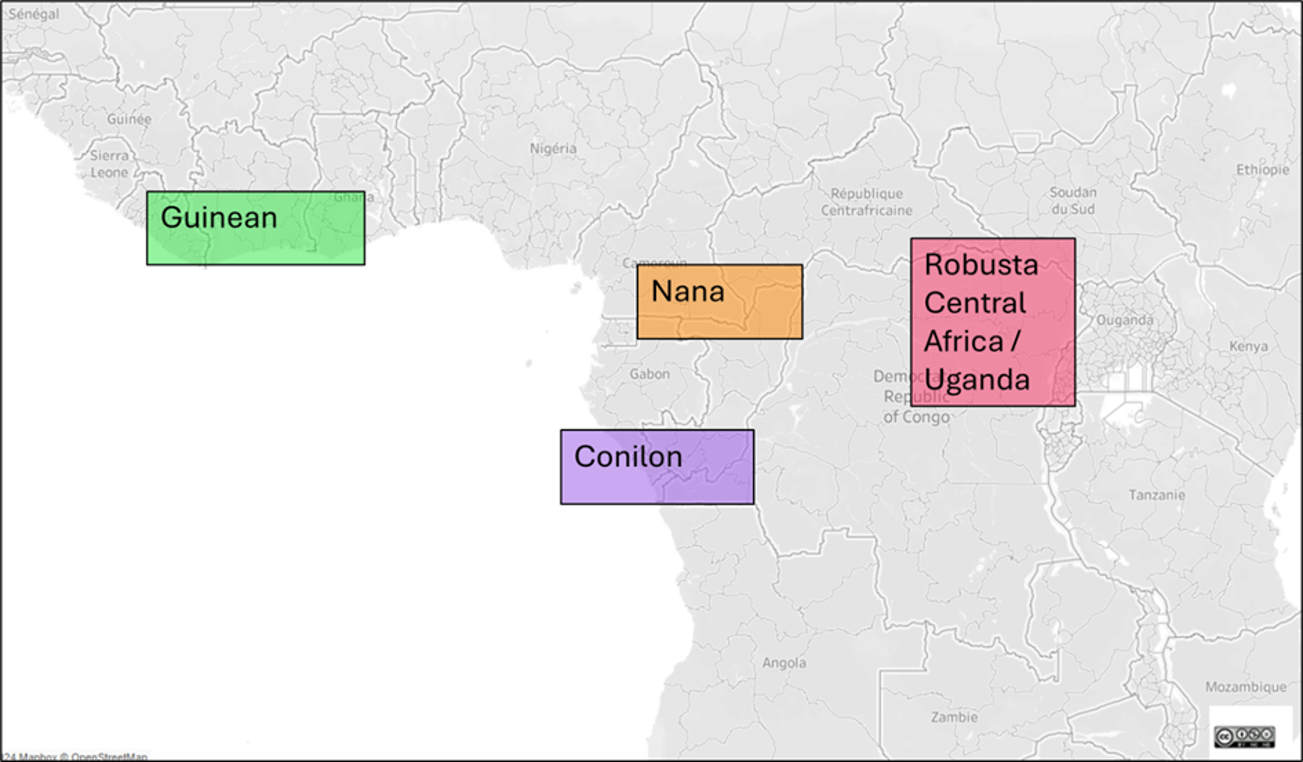C. canephora history and genetic diversity
Coffea canephora produces the coffee commercially known as Robusta or Conilon. Robusta and Conilon are two botanical varieties of C. canephora corresponding to two of the four different genetic groups of the species.
C. canephora‘s native habitat – where it occurs in the wild – stretches from west to east, from Guinea to Uganda, and from north to south, from the Central African Republic to Angola.
Based on the knowledge of the genetic diversity of C. canephora, we can summarize that there are four major genetic groups in this species.
- The “Guinean” group originated in West Africa, mainly in Guinea and Côte d’Ivoire.
- The “Nana” group has its origins on the borders of Cameroon, Congo and the Central African Republic.
- The “Conilon” group has its origins on the Atlantic coast of Central Africa, from Gabon to Angola.
- The “Robusta” group’s origins cover the Congo Basin, part of the Central African Republic and Uganda.

Each of these groups can be subdivided, in particular the large “Robusta” group, but this level of structuring with four genetic groups is sufficient to understand the diversity of the C. canephora species.
Cultivation of C. canephora began independently and almost anecdotally at the end of the 19th century in various areas of the species’ native habitat in Africa, notably Uganda and Gabon. Today, however, only two major genetic groups play a significant role in C. canephora cultivation worldwide. The “Robusta” group is the origin of canephora coffee grown in Uganda of course, but also in Asia, particularly in India, Vietnam and Indonesia. The canephora coffee trees traditionally grown in Central America (Guatemala) and Mexico are also from the “Robusta” genetic group.
The cultivation of the C. canephora species in Brazil has a radically different geographical and genetic origin. The coffee, called Conilon, comes from the genetic group of the same name. In fact, the original name is “Kouilou”, corresponding to a region and river of the same name on the Atlantic coast of the Congo. A typological error when “Kouilou” arrived in Brazil gave Konilon (the “u” became an “n”), and then Conilon.
The Nana group has not been significantly involved in the cultivation of C. canephora, with the exception of a few local landraces.
The same applies to the “Guinean” group. However, this group has given rise to a few landraces known (at least in the past) in Guinea: Gamé and Maclaudii. The “Guinean” group is also important, as it has been involved in crosses with parents from the “Robusta” or “Conilon” groups to produce high-performance varieties bred in Côte d’Ivoire, but which are not grown to any significant extent outside this country.
In the Amazon region of Brazil, selected C. canephora varieties are derived from crosses between the Conilon and Robusta groups.
Finally, it is worth noting that some few cultivars originating from interspecific crosses between C. canephora and C. congensis, named Congustas. CxR, from India, is one significant Congusta cultivar.
Main scientific references :
Montagnon, C., Leroy, T., & Eskes, A. B. (1998). Varietal improvement of Coffea canephora. I. Criteria and breeding methods. Plantations, recherche, développement, 5, 18-28. (Here)
Montagnon, C., Leroy, T., & Eskes, A. B. (1998). Varietal improvement of Coffea canephora. II. Breeding programmes and their results. Plantations, recherche, développement, 5(2), 89-98. (Here)
Cubry, P., De Bellis, F., Pot, D., Musoli, P., & Leroy, T. (2013). Global analysis of Coffea canephora Pierre ex Froehner (Rubiaceae) from the Guineo-Congolese region reveals impacts from climatic refuges and migration effects. Genetic Resources and Crop Evolution, 60, 483-501. (Here)
Garavito, A., Montagnon, C., Guyot, R., & Bertrand, B. (2016). Identification by the DArTseq method of the genetic origin of the Coffea canephora cultivated in Vietnam and Mexico. BMC Plant Biology, 16, 1-12. (Here)
Merot‐l’Anthoene, V., Tournebize, R., Darracq, O., Rattina, V., Lepelley, M., Bellanger, L., … & Poncet, V. (2019). Development and evaluation of a genome‐wide Coffee 8.5 K SNP array and its application for high‐density genetic mapping and for investigating the origin of Coffea arabica L. Plant biotechnology journal, 17(7), 1418-1430. (Here)
Labouisse, J. P., Cubry, P., Austerlitz, F., Rivallan, R., & Nguyen, H. A. (2020). New insights on spatial genetic structure and diversity of Coffea canephora (Rubiaceae) in Upper Guinea based on old herbaria. Plant Ecology and Evolution, 153(1), 82-100. (Here)
